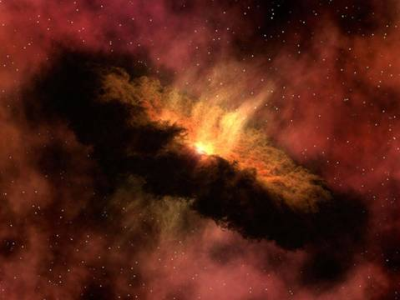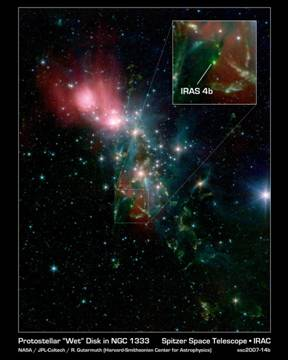04 September 2007

NASA's Spitzer Space Telescope observed a fledgling solar system like the one depicted in this artist's impression, and discovered deep within it enough water vapor to fill the oceans on Earth five times.
Credit: NASA/JPL-Caltech
NASA's Spitzer Space Telescope (SST) detected large amounts of water vapor inside the collapsing cloud of a forming star system. Astronomers believe the water vapor is pouring down from the cloud and impacting a dusty disk where planets are believed to form.
The observations provide the first direct view of how water, an essential ingredient for life as we know it, begins to make its way into planets, possibly even rocky, Earth-like planets.
"For the first time, we are seeing water being delivered to the region where planets will most likely form," said Dan Watson of the University of Rochester. Watson is the principal author of a paper about this "steamy" young star system.
The star system, known as NGC 1333-IRAS 4B, is still evolving inside a cool cocoon of gas and dust. Within this cocoon, circling around the embryonic star, is a growing, warm disk of planet-forming materials. The new Spitzer data indicate that ice from the stellar embryo's outer cocoon is falling toward the forming star and vaporizing as it impacts the disk.

This image from Spitzer shows the stellar nursery, known as NGC 1333, that contains the "steamy" young solar system, termed NGC 1333-IRAS 4B.
"On Earth, water arrived in the form of icy asteroids and comets. Water also exists mostly as ice in the dense clouds that form stars," said Watson. "Now we have seen that water, falling as ice from a young star system's envelope to its disk, actually vaporizes on arrival. This water vapor will later freeze again into asteroids and comets."
Water is plentiful in the Universe. Water has been detected in the form of ice or gas around various types of stars, in interstellar space, and recently Spitzer picked up the first clear signature of water vapor on a hot, gaseous planet outside our Solar System, known as HD 189733b.
The new Spitzer study demonstrates that water also serves as an important tool for studying long-sought details of planet formation. Astronomers can learn about the disk of NGC 1333-IRAS 4B by studying this water. For example, they calculated the disk's density (at least 10 billion hydrogen molecules per cubic centimeter); its dimensions (a radius bigger than the average distance between Earth and Pluto); and its temperature (170° Kelvin).
"Water is easier to detect than other molecules, so we can use it as a probe to look at more brand-new disks and study their physics and chemistry," said Watson. "This will teach us a lot about how planets form."
Watson and his colleagues observed 30 of the youngest known stellar embryos applying Spitzer's infrared spectrograph, an instrument that spreads infrared light into a spectrum of wavelengths, revealing characteristic spectral lines of molecules. Of the 30 stellar embryos, only NGC 1333-IRAS 4B showed a whopping signature of water vapor. This vapor is readily detectable by Spitzer, because as ice hits the stellar embryo's disk, it heats up very rapidly and glows with infrared emission.
Astronomers believe that NGC 1333-IRAS 4B was the only stellar embryo to show signs of water because it is in the right orientation for Spitzer to view its dense core. Also, this particular watery phase of a star's life is short-lived and difficult to find.
"We have captured a unique phase of a young star's evolution, when the stuff of life is moving dynamically into an environment where planets could form," said Michael Werner, project scientist for the Spitzer mission at NASA's Jet Propulsion Laboratory (JPL).
NGC 1333-IRAS 4B is located in a star-birth region approximately 1,000 light-years away in the constellation Perseus. Its central stellar embryo is still evolving and growing in size. At this early stage, astronomers cannot determine how large the star will ultimately get.
Further Reading
SST
http://www.spitzer.caltech.edu/spitzer/
Planet Quest
http://planetquest.jpl.nasa.gov/index.cfm
Aymen Mohamed Ibrahem
Senior Astronomy Specialist